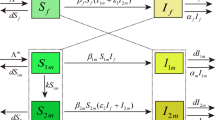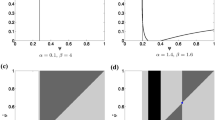Abstract
A sexually-transmitted disease model for two strains of pathogen in a one-sex, heterogeneously-mixing population was proposed by Li et al. in (J Math Biol 10:1037–1052, 1986). The sufficient and necessary conditions for coexistence and the sufficient conditions for stability of the boundary equilibria were provided. This paper will present a thorough classification of dynamics for this model in terms of the first and second so called reproductive numbers of infection in strains I and J. This classification not only solves a conjecture proposed in (Li et al., J Math Biol 10:1037–1052, 1986) but also gives the sufficient and necessary conditions for the competitive exclusion.
Similar content being viewed by others
References
Anderson R.M. and May R.R. (1982). Co-evolution of host and parasites. Parasitology. 85: 411–426
Anderson R.M. and May R.R. (1991). Infectious Diseases of Humans. Oxford Science Publications, Oxford
Beck K. (1984). Co-evolution. Mathematical aspects of host-parasite interactions. J. Math. Biol. 19: 63–77
Berman A., Neumann M. and Stren R. (1989). Nonnegative Martices in Dynamics Systems. Wiley, New York
Bremermann H.J. and Thieme H.R. (1989). A competitive exclusion principle for pathogen virulence. J. Math. Biol. 27: 179–190
Capasso, V.: In: Mathematical Structures of Epidemic Systems. Lecture Notes in Biomath. 97, Springer, Heidelberg (1993)
Castillo-Chavez C., Hethcote H.W., Andreasen V., Levin S.A. and Liu W.M. (1988). Cross-immunity in the dynamics of homogeneous and heterogeneous populations. In: Hallam, T.G., Gross, L.G., and Levin, S.A. (eds) Mathematical Ecology., pp 303–316. World Scientific, Singapore
Castillo-Chavez C., Huang W. and Li J. (1996). Competitive exclusion in gonorrhea models and other sexually transmitted diseases. SIAM J. Appl. Math. 56: 494–508
Castillo-Chavez C., Huang W. and Li J. (1996). The effects of female’s susceptibility on coexistence of multiple pathogen strains of sexually transmitted diseases. J. Math. Biol. 35: 503–522
Castillo-Chavez C., Huang W. and Li J. (1999). Competitive exclusion and coexistence of multiple strains in an SIS STD model. SIAM J. Appl. Math. 59: 1790–1811
Castillo-Chavez C., Huang W. and Li J. (1995). Dynamics of multiple pathogen strains in heterosexual epidemiological models. In: Martelli, M., Cooke, K., Cumberbatch, E., Tang, B., and Thieme, H. (eds) Differential Equations and Applications to Biology and Industry, pp 288–298. World Scientific, Singapore
Dietz K. (1979). Epidemiologic interference of virus populations. J. Math. Biol. 8: 291–300
Dwyer G., Levin S.A. and Buttel L. (1990). A simulation model of the population dynamics and evolution of myxomatosis. Ecol. Monogr. 60: 423–447
Ewald W.P. (1994). Evolution of Infectious Disease. Oxford University Press, Oxford
Hethcote H.W. (2000). The mathematics of infectious diseases. SIAM Rev. 42: 599–563
Hethcote, H.W., Yoke, J.A.: Gonorrhea Transmission Dynamics and Control. Lect. Notes Biomath. vol. 56, Springer, New York (1984)
Levin, S.A.: Co-evolution, in Population Biology. In: Freedman, H.I., Strobeck, C. (eds.), Lecture Notes Biomath. vol. 52, 328–334 Springer, New York (1983)
Levin S.A. (1983). Some approaches to the modeling of co-evolutionary interactions. In: Nitecki, M. (eds) Co-evolution., pp 21–65. University of Chicago Press, Chicago
Li J., Ma Z., Blythe S.P. and Castillo-Chavez C. (2003). Coexistence of pathogens in sexually-transmitted disease models. J. Math. Biol. 47: 547–568
May R.M. (1973). Stability and Complexity in Model Ecosystems. Princeton University Press, Princeton
May R.M. and Anderson R.M. (1983). Epidemiology and genetics in the co-evolution of parasites and hosts. Philos. Trans. R. Soc. Lond. B 219: 282–313
May R.M. and Anderson R.M. (1990). Parasite-host coevolution. Parasitology 100: S89–S101
Maynard Smith J. (1978). The Evolution of Sex. Cambridge University Press, Cambridge
Smith H.L. (1986). Competing subcommunities of mutualists and a generalized Kamke theorem. SIAM J. Appl. Math. 46: 856–874
Smith H.L. (1986). Cooperative systems of differential equations with concave nonlinearities. Nonlinear Anal. 10: 1037–1052
Author information
Authors and Affiliations
Corresponding author
Additional information
Supported by the NSF of China grants 10531030 and 10671143.
Rights and permissions
About this article
Cite this article
Jiang, J., Chai, C. The complete classification for dynamics in a homosexually-transmitted disease model. J. Math. Biol. 56, 373–390 (2008). https://doi.org/10.1007/s00285-007-0119-1
Received:
Revised:
Published:
Issue Date:
DOI: https://doi.org/10.1007/s00285-007-0119-1




